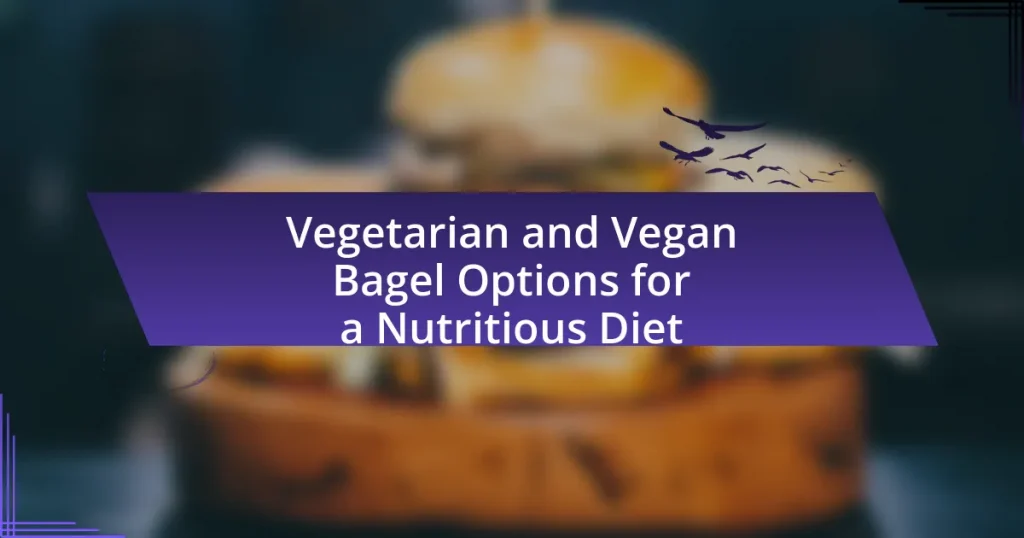Healthy bagel sandwiches for weight loss are nutritious options made with whole grain or low-calorie bagels, filled with lean proteins, fresh vegetables, and healthy fats. These sandwiches promote satiety and provide essential nutrients, making them a strategic choice for weight management. Key components include whole grain bagels, lean proteins like turkey or chicken, and a variety of vegetables such as spinach and tomatoes. Portion control and mindful ingredient selection are crucial for maximizing weight loss benefits. Additionally, the article explores the nutritional advantages of whole grain bagels, the role of vegetables in enhancing flavor, and tips for meal prepping and storing these sandwiches effectively.

What are Healthy Bagel Sandwiches for Weight Loss?
Healthy bagel sandwiches for weight loss are sandwiches made with whole grain or low-calorie bagels, filled with nutrient-dense ingredients that promote satiety and provide essential nutrients. These sandwiches typically include lean proteins such as turkey, chicken, or plant-based options, along with plenty of vegetables like spinach, tomatoes, and cucumbers, and healthy fats from sources like avocado or hummus. Research indicates that incorporating high-fiber and high-protein foods can aid in weight management by enhancing feelings of fullness and reducing overall calorie intake.
How do Healthy Bagel Sandwiches contribute to weight loss?
Healthy bagel sandwiches contribute to weight loss by providing a balanced meal option that can be lower in calories and higher in nutrients compared to traditional sandwiches. These sandwiches often incorporate whole grain bagels, lean proteins, and plenty of vegetables, which can enhance satiety and reduce overall calorie intake. For instance, a whole grain bagel contains fiber that aids digestion and promotes fullness, while lean proteins like turkey or chicken can help maintain muscle mass during weight loss. Additionally, incorporating vegetables adds essential vitamins and minerals without significantly increasing calorie content, making healthy bagel sandwiches a strategic choice for those aiming to lose weight.
What ingredients make a bagel sandwich healthy?
Whole grain bagels, lean proteins, fresh vegetables, and healthy fats make a bagel sandwich healthy. Whole grain bagels provide more fiber and nutrients compared to refined options, aiding digestion and promoting satiety. Lean proteins, such as turkey or chicken breast, contribute essential amino acids while being lower in saturated fat. Fresh vegetables like spinach, tomatoes, and cucumbers add vitamins, minerals, and antioxidants, enhancing overall nutritional value. Healthy fats from sources like avocado or hummus support heart health and improve nutrient absorption. These ingredients collectively create a balanced meal that supports weight loss and overall health.
How do portion sizes affect weight loss with bagel sandwiches?
Portion sizes significantly affect weight loss with bagel sandwiches by directly influencing caloric intake. Consuming larger portions increases the total calories consumed, which can hinder weight loss efforts. Research indicates that individuals who are mindful of portion sizes tend to consume fewer calories overall, leading to more effective weight management. For instance, a study published in the American Journal of Clinical Nutrition found that reducing portion sizes can lead to a decrease in energy intake, thereby supporting weight loss. Therefore, managing portion sizes of bagel sandwiches is crucial for achieving weight loss goals.
Why choose bagels over other bread options for weight loss?
Bagels can be a better choice for weight loss compared to other bread options due to their lower calorie density and higher satiety factor. A standard bagel typically contains around 250-300 calories, while many slices of bread can add up to a similar or higher calorie count when multiple slices are used for a sandwich. Additionally, bagels are often denser and chewier, which can lead to increased feelings of fullness, potentially reducing overall calorie intake. Studies indicate that foods with higher satiety levels can help control hunger and promote weight loss, making bagels a strategic option when consumed mindfully.
What are the nutritional benefits of whole grain bagels?
Whole grain bagels offer several nutritional benefits, including higher fiber content, essential vitamins, and minerals compared to refined bagels. The fiber in whole grain bagels aids in digestion and promotes satiety, which can help with weight management. Additionally, whole grains are rich in B vitamins, such as thiamine and niacin, which support energy metabolism. They also contain important minerals like iron and magnesium, contributing to overall health. Studies indicate that diets high in whole grains are associated with a lower risk of chronic diseases, including heart disease and type 2 diabetes, reinforcing the health benefits of incorporating whole grain bagels into a balanced diet.
How do bagels compare to other types of bread in terms of calories?
Bagels typically contain more calories than most other types of bread. A standard plain bagel has approximately 250 to 300 calories, while a slice of whole wheat bread usually contains around 70 to 80 calories. This significant difference in calorie content is due to the denser composition of bagels, which are boiled before baking, resulting in a chewy texture and higher calorie density.

What are the key components of a Healthy Bagel Sandwich?
A healthy bagel sandwich consists of a whole grain bagel, lean protein, fresh vegetables, and a healthy spread. Whole grain bagels provide fiber and essential nutrients, while lean proteins such as turkey, chicken, or hummus contribute to satiety and muscle maintenance. Fresh vegetables like spinach, tomatoes, and cucumbers add vitamins, minerals, and antioxidants, enhancing the nutritional profile. Healthy spreads, such as avocado or low-fat cream cheese, offer healthy fats and flavor without excessive calories. This combination supports weight loss by promoting fullness and providing balanced nutrition.
What types of proteins can be included in a healthy bagel sandwich?
A healthy bagel sandwich can include proteins such as turkey, chicken breast, smoked salmon, tofu, or hummus. These protein sources are low in saturated fat and high in essential nutrients, making them suitable for weight loss. For instance, turkey and chicken breast are lean meats that provide high-quality protein with fewer calories, while smoked salmon offers omega-3 fatty acids beneficial for heart health. Tofu and hummus are excellent plant-based options that contribute to protein intake without animal fats.
How do lean proteins support weight loss?
Lean proteins support weight loss by promoting satiety and increasing metabolic rate. Consuming lean proteins, such as chicken breast or fish, helps individuals feel fuller for longer periods, which can reduce overall calorie intake. Additionally, the thermic effect of food (TEF) associated with protein consumption is higher than that of fats or carbohydrates, meaning the body burns more calories digesting proteins. Research indicates that diets higher in protein can lead to greater weight loss and fat loss compared to lower protein diets, as evidenced by a study published in the American Journal of Clinical Nutrition, which found that participants on a high-protein diet lost more weight and maintained muscle mass better than those on a standard protein diet.
What are some vegetarian protein options for bagel sandwiches?
Vegetarian protein options for bagel sandwiches include hummus, tofu, tempeh, and various legumes such as chickpeas and black beans. Hummus provides approximately 8 grams of protein per 100 grams, making it a nutritious spread. Tofu, with about 8 grams of protein per 100 grams, can be grilled or scrambled for added texture. Tempeh offers around 19 grams of protein per 100 grams and has a firm texture that complements bagels well. Additionally, legumes like chickpeas and black beans can be mashed or used in salads, contributing around 7-9 grams of protein per 100 grams. These options not only enhance the protein content of bagel sandwiches but also support a balanced diet.
What vegetables should be included for maximum health benefits?
To maximize health benefits, include spinach, kale, bell peppers, tomatoes, and cucumbers in your diet. Spinach and kale are rich in vitamins A, C, and K, as well as antioxidants that support immune function and reduce inflammation. Bell peppers provide high levels of vitamin C and various phytonutrients that promote heart health. Tomatoes contain lycopene, which has been linked to reduced risk of certain cancers and heart disease. Cucumbers are hydrating and low in calories, making them an excellent choice for weight management. Incorporating these vegetables into meals, such as healthy bagel sandwiches, enhances nutritional value and supports overall health.
Which vegetables are low in calories but high in nutrients?
Vegetables that are low in calories but high in nutrients include spinach, kale, broccoli, zucchini, and bell peppers. Spinach contains only 7 calories per cup while providing significant amounts of vitamins A, C, and K, as well as iron and calcium. Kale, with 33 calories per cup, is rich in vitamins A, C, and K, along with antioxidants. Broccoli has 55 calories per cup and is an excellent source of vitamins C and K, fiber, and folate. Zucchini offers 19 calories per cup and is high in vitamin C and potassium. Bell peppers, with 24 calories per cup, are loaded with vitamins A and C, as well as various antioxidants. These vegetables are ideal for creating healthy bagel sandwiches that support weight loss while delivering essential nutrients.
How can vegetables enhance the flavor of bagel sandwiches?
Vegetables enhance the flavor of bagel sandwiches by adding freshness, crunch, and a variety of tastes that complement the bread and fillings. For instance, tomatoes provide juiciness and acidity, while cucumbers contribute a crisp texture. Bell peppers add sweetness and a slight crunch, and leafy greens like spinach or arugula introduce a peppery note. These flavor profiles not only elevate the overall taste but also create a balanced sandwich that can satisfy diverse palates. Additionally, incorporating vegetables can increase the nutritional value, providing essential vitamins and minerals that support weight loss, as they are typically low in calories and high in fiber.

How can you customize Healthy Bagel Sandwiches for weight loss?
To customize Healthy Bagel Sandwiches for weight loss, opt for whole grain or low-calorie bagels, and fill them with lean proteins such as turkey or chicken breast, along with plenty of vegetables like spinach, tomatoes, and cucumbers. This approach reduces calorie intake while providing essential nutrients. Research indicates that incorporating high-fiber foods, such as vegetables, can enhance satiety and aid in weight management. Additionally, using low-fat spreads or skipping high-calorie condiments can further decrease overall calories, making the sandwich more conducive to weight loss.
What are some creative spreads that can be used?
Creative spreads for healthy bagel sandwiches include hummus, avocado, Greek yogurt, and nut butters. Hummus provides a protein-rich, flavorful option that can be enhanced with spices or herbs. Avocado offers healthy fats and a creamy texture, making it a satisfying choice. Greek yogurt serves as a low-calorie, high-protein alternative to cream cheese, and can be flavored with herbs or spices for variety. Nut butters, such as almond or peanut butter, add healthy fats and protein, complementing sweet toppings like banana or honey. These spreads not only enhance flavor but also contribute to a balanced nutritional profile, supporting weight loss goals.
How do low-calorie spreads compare to traditional options?
Low-calorie spreads generally contain fewer calories and less fat than traditional options, making them a popular choice for those aiming to reduce caloric intake. For instance, a typical low-calorie spread may have around 30-50 calories per serving, while traditional butter or cream cheese can contain 100-200 calories per serving. This significant difference allows individuals to enjoy flavor without consuming excess calories, which is particularly beneficial for weight loss. Additionally, many low-calorie spreads are formulated with ingredients that provide similar taste and texture to their higher-calorie counterparts, often using water, air, or vegetable extracts to achieve this.
What are some homemade spread recipes for bagel sandwiches?
Homemade spread recipes for bagel sandwiches include cream cheese variations, avocado spread, hummus, and nut butter. Cream cheese can be enhanced with herbs, garlic, or smoked salmon for added flavor. Avocado spread is made by mashing ripe avocados with lime juice, salt, and pepper, providing healthy fats. Hummus, made from blended chickpeas, tahini, lemon juice, and garlic, offers a protein-rich option. Nut butter, such as almond or peanut butter, can be paired with banana slices for a nutritious and satisfying spread. These spreads contribute to a balanced diet while enjoying bagel sandwiches.
How can you balance flavors while keeping it healthy?
To balance flavors while keeping it healthy, incorporate a variety of fresh herbs, spices, and natural ingredients that enhance taste without adding excessive calories or unhealthy fats. For example, using ingredients like avocado, hummus, or Greek yogurt can provide creaminess and flavor while offering nutritional benefits such as healthy fats and protein. Additionally, selecting whole grain bagels increases fiber content, which aids in satiety and overall health. Research indicates that flavor balance can be achieved by combining sweet, salty, sour, and umami elements, which can be done using ingredients like tomatoes, cucumbers, and lean proteins. This approach not only enhances the taste but also maintains a focus on health, supporting weight loss goals effectively.
What herbs and spices can enhance taste without adding calories?
Herbs and spices that can enhance taste without adding calories include basil, oregano, thyme, rosemary, garlic powder, onion powder, paprika, cumin, and black pepper. These flavor enhancers provide robust taste profiles while containing negligible or zero calories. For instance, basil and oregano are commonly used in Mediterranean cuisine and are known for their aromatic qualities, while spices like cumin and paprika add depth and warmth to dishes without contributing caloric content.
How can you incorporate healthy fats into your bagel sandwich?
To incorporate healthy fats into your bagel sandwich, use ingredients such as avocado, nut butters, or olive oil-based spreads. Avocado provides monounsaturated fats, which are beneficial for heart health and can help with weight management. Nut butters, like almond or peanut butter, offer healthy fats and protein, contributing to satiety. Additionally, using olive oil-based spreads can enhance flavor while adding healthy fats. These options not only improve the nutritional profile of your bagel sandwich but also support weight loss by promoting fullness and reducing cravings.
What are some tips for meal prepping Healthy Bagel Sandwiches?
To meal prep Healthy Bagel Sandwiches, start by selecting whole grain or sprouted bagels for added fiber and nutrients. Prepare fillings in advance, such as lean proteins like turkey or chicken, and fresh vegetables like spinach or tomatoes, which can be stored separately to maintain freshness. Use low-fat spreads like hummus or avocado to enhance flavor without excess calories. Assemble the sandwiches just before consumption to prevent sogginess, and store them in airtight containers in the refrigerator for up to three days. This method ensures that the sandwiches remain nutritious and convenient for weight loss goals.
How can you store bagel sandwiches to maintain freshness?
To maintain the freshness of bagel sandwiches, store them in an airtight container or wrap them tightly in plastic wrap. This method prevents air exposure, which can lead to staleness. Additionally, refrigerating bagel sandwiches can extend their freshness for a few days, while freezing them allows for longer storage, up to three months. When ready to eat, thaw frozen sandwiches in the refrigerator overnight and reheat them in an oven or toaster for optimal texture.
What are the best practices for assembling sandwiches in advance?
The best practices for assembling sandwiches in advance include using sturdy bread, separating wet ingredients, and storing them properly. Sturdy bread, such as whole grain or bagels, prevents sogginess and maintains texture. Separating wet ingredients, like sauces or tomatoes, until serving time helps keep the sandwich fresh. Proper storage in airtight containers or wrapping in foil minimizes exposure to air, preserving flavor and preventing spoilage. These practices ensure that sandwiches remain appealing and safe to eat, supporting the goal of creating healthy bagel sandwiches for weight loss.



